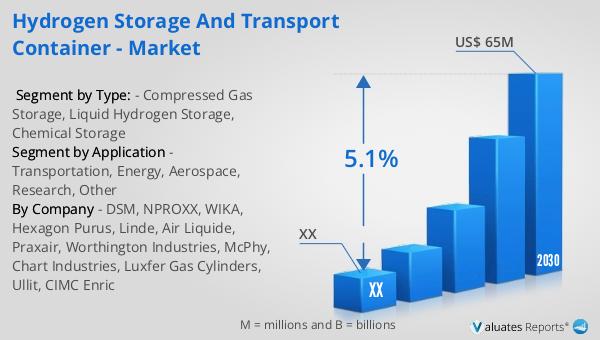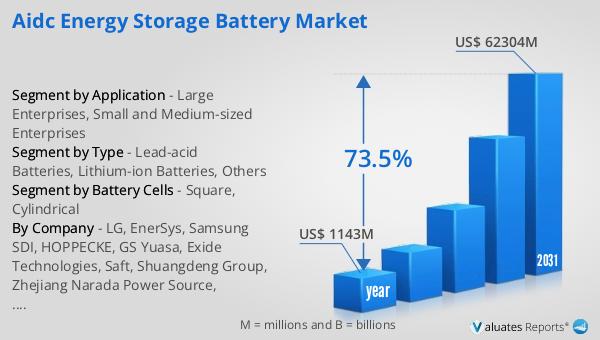What is Hydrogen Storage and Transport Container - Global Market?
Hydrogen storage and transport containers are essential components in the global market, playing a crucial role in the burgeoning hydrogen economy. These containers are designed to safely store and transport hydrogen, a clean and efficient energy carrier, across various sectors. The global market for these containers is driven by the increasing demand for hydrogen as a sustainable energy source, which is being adopted in numerous industries such as transportation, energy, and manufacturing. The containers must meet stringent safety standards due to hydrogen's highly flammable nature, and they come in various forms, including compressed gas cylinders, liquid hydrogen tanks, and chemical storage systems. As the world shifts towards cleaner energy solutions, the demand for hydrogen storage and transport containers is expected to grow, driven by technological advancements and supportive government policies. This market is characterized by continuous innovation, as manufacturers strive to improve the efficiency, safety, and cost-effectiveness of these containers to meet the evolving needs of the hydrogen economy. The global market for hydrogen storage and transport containers is poised for significant growth, reflecting the broader trend towards sustainable energy solutions.

Compressed Gas Storage, Liquid Hydrogen Storage, Chemical Storage in the Hydrogen Storage and Transport Container - Global Market:
Compressed gas storage, liquid hydrogen storage, and chemical storage are three primary methods used in the hydrogen storage and transport container market. Compressed gas storage involves storing hydrogen in high-pressure cylinders, typically at pressures ranging from 350 to 700 bar. This method is widely used due to its simplicity and the relatively low cost of the storage containers. However, the high pressure required for storage poses safety challenges, necessitating robust materials and designs to prevent leaks and ensure safe handling. Liquid hydrogen storage, on the other hand, involves cooling hydrogen to cryogenic temperatures (-253°C) to convert it into a liquid state. This method allows for higher energy density compared to compressed gas storage, making it suitable for applications where space is limited, such as in aerospace and long-distance transportation. However, the process of liquefying hydrogen is energy-intensive and requires specialized insulated containers to maintain the low temperatures, which can increase costs. Chemical storage involves storing hydrogen in chemical compounds, such as metal hydrides or ammonia, which release hydrogen when needed. This method offers the advantage of lower storage pressures and temperatures, enhancing safety and ease of transport. However, the development of efficient and cost-effective chemical storage materials remains a challenge, as the release and absorption of hydrogen can be slow and require specific conditions. Each of these storage methods has its own set of advantages and challenges, and the choice of method depends on the specific requirements of the application, such as storage capacity, safety, cost, and ease of transport. As the hydrogen economy continues to grow, ongoing research and development efforts are focused on improving these storage technologies to enhance their efficiency, safety, and cost-effectiveness.
Transportation, Energy, Aerospace, Research, Other in the Hydrogen Storage and Transport Container - Global Market:
Hydrogen storage and transport containers are utilized across various sectors, each with unique requirements and challenges. In the transportation sector, hydrogen is increasingly being used as a clean fuel alternative for vehicles, including cars, buses, and trucks. Hydrogen fuel cell vehicles require efficient storage solutions to ensure a sufficient driving range and quick refueling times. Compressed gas storage is commonly used in this sector due to its relatively low cost and established infrastructure. In the energy sector, hydrogen is used for energy storage and grid balancing, providing a means to store excess renewable energy generated from sources like wind and solar. Liquid hydrogen storage is often preferred in this sector due to its higher energy density, which allows for large-scale storage and transport. In the aerospace industry, hydrogen is used as a fuel for rockets and potentially for future aircraft. The high energy density of liquid hydrogen makes it an ideal choice for aerospace applications, where weight and space are critical considerations. In research, hydrogen storage and transport containers are used in various experimental setups to study hydrogen's properties and potential applications. Researchers often require flexible and safe storage solutions that can be easily integrated into laboratory environments. Other sectors, such as manufacturing and industrial processes, also utilize hydrogen storage and transport containers to support hydrogen-based applications, such as metal refining and chemical production. Each of these sectors has specific requirements for hydrogen storage and transport, driving the development of tailored solutions to meet their unique needs. As the hydrogen economy expands, the demand for versatile and efficient storage and transport solutions is expected to grow, supporting the broader adoption of hydrogen as a clean energy source.
Hydrogen Storage and Transport Container - Global Market Outlook:
The global market for hydrogen storage and transport containers was valued at approximately $46 million in 2023. This market is projected to grow to a revised size of $65 million by 2030, reflecting a compound annual growth rate (CAGR) of 5.1% during the forecast period from 2024 to 2030. This growth is driven by the increasing adoption of hydrogen as a clean energy source across various industries, including transportation, energy, and manufacturing. The market's expansion is supported by technological advancements in storage and transport solutions, as well as favorable government policies promoting the use of hydrogen as a sustainable energy carrier. The demand for hydrogen storage and transport containers is expected to rise as more industries transition towards cleaner energy solutions, necessitating efficient and safe storage and transport options. The market is characterized by continuous innovation, with manufacturers focusing on improving the efficiency, safety, and cost-effectiveness of their products to meet the evolving needs of the hydrogen economy. As the world moves towards a more sustainable energy future, the hydrogen storage and transport container market is poised for significant growth, reflecting the broader trend towards clean energy solutions.
| Report Metric | Details |
| Report Name | Hydrogen Storage and Transport Container - Market |
| Forecasted market size in 2030 | US$ 65 million |
| CAGR | 5.1% |
| Forecasted years | 2024 - 2030 |
| Segment by Type: |
|
| Segment by Application |
|
| By Region |
|
| By Company | DSM, NPROXX, WIKA, Hexagon Purus, Linde, Air Liquide, Praxair, Worthington Industries, McPhy, Chart Industries, Luxfer Gas Cylinders, Ullit, CIMC Enric |
| Forecast units | USD million in value |
| Report coverage | Revenue and volume forecast, company share, competitive landscape, growth factors and trends |
